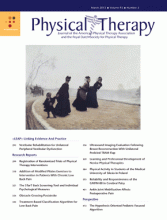Abstract
Background Physical therapists frequently use joint mobilization therapy techniques to treat people with musculoskeletal dysfunction and pain. Several studies suggest that endogenous adenosine may act in an analgesic fashion in various pain states.
Objective The purpose of this study was to investigate the contribution of the adenosinergic system on the antihyperalgesic effect of ankle joint mobilization (AJM).
Design This was a experimental study.
Methods To test the hypothesis that the adrenosinergic system is involved in the antihyperalgesic effect of AJM, mice (25–35 g) submitted to plantar incision surgery were used as a model of acute postoperative pain. The mice were subjected to AJM for 9 minutes. Withdrawal frequency to mechanical stimuli was assessed 24 hours after plantar incision surgery and 30 minutes after AJM, adenosine, clonidine, or morphine treatments. The adenosinergic system was assessed by systemic (intraperitoneal), central (intrathecal), and peripheral (intraplantar) administration of caffeine. The participation of the A1 receptor was investigated using a selective adenosine A1 receptor subtype antagonist. In addition, previous data on the involvement of the serotonergic and noradrenergic systems in the antihyperalgesic effect of AJM were confirmed.
Results Ankle joint mobilization decreased mechanical hyperalgesia, and this effect was reversed by pretreatment of the animals with caffeine given by intraperitoneal, intraplantar, and intrathecal routes. In addition, intraplanar and intrathecal administrations of 1,3-dipropyl-8-cyclopentylxanthine (DPCPX, a selective adenosine A1 subtype receptor antagonist) or systemic administration of yohimbine or ρ-chlorophenylalanine methyl ester hydrochloride (PCPA) blocked the antihyperalgesia induced by AJM.
Limitations The results are limited to animal models and cannot be generalized to acute pain in humans.
Conclusions This study demonstrated the involvement of the adenosinergic system in the antihyperalgesic effect of AJM in a rodent model of pain and provides a possible mechanism basis for AJM-induced relief of acute pain.
Footnotes
Mr Martins, Ms Mazzardo-Martins, Mr Cidral-Filho, and Dr Santos provided concept/idea/research design and writing. All authors provided data collection. Mr Martins, Ms Mazzardo-Martins, and Ms Stramosk provided data analysis. Dr Santos provided project management, fund procurement, and facilities/equipment.
This work was supported by grants from Conselho Nacional de Desenvolvimento Científico e Tecnológico (CNPq), Fundação de Amparo à Pesquisa e Inovação do Estado de Santa Catarina (FAPESC), Coordenação de Aperfeiçoamento de Pessoal de Niível Superior (CAPES), and Universidade do Sul de Santa Catarina (UNISUL), Brazil.
- Received June 4, 2012.
- Accepted October 10, 2012.












